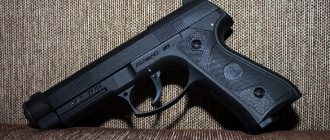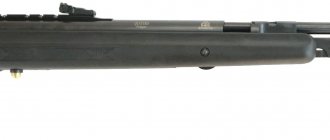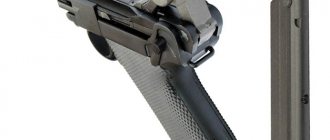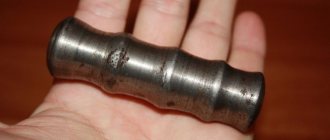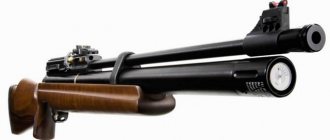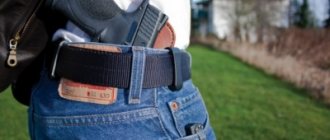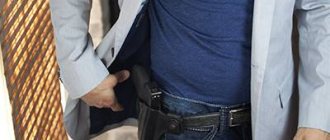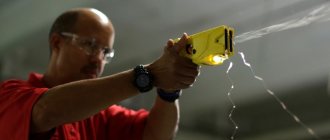The principle of operation and design of pneumatic weapons
Pneumatic weapons are distinguished by their complexity of design and operating principle:
- Single injection systems. Pros: high power. Disadvantages - coordinated and precise operation of all valve systems is required.
- The spring-piston design is simple, powerful and reliable. The piston allows you to provide the required pressure by expanding the spring.
- Pre-loaded weapons are the strongest and most complex in their design. The storage tank contains compressed air up to 350 atm, and is a built-in or removable tank.
- A multi-compression weapon is a sophisticated pneumatic design with a single injection with an additional capacity to create high pressure. It is distinguished by the ability to fire a series of shots on one pump.
- Pistols with cartridge pumping. They are similar to military weapons, the only difference is that the shot occurs due to air under pressure.
- Weapons using carbon dioxide (CO2). A separate cylinder with liquefied gas is installed.
Carbon dioxide air guns
A gas pistol is the most popular type of pneumatic. The weapon operates using gas cylinders. Many manufacturers have chosen a tank format that is familiar to many from the times of the Soviet Union. These cylinders were installed in soda siphons. Some companies offer their developments. Their cylinders contain lubricant to extend the life of sealing gaskets and springs.
CO2 pneumatics have many advantages: installing the cylinder is easy, and the adjustable air supply system ensures stable shooting. Before the pressure drops critically, the weapon can fire many shots. The standard value for various designs is 50.
CO2 weapons are exposed to the external environment. The pressure in the can decreases at low temperatures.
In addition, it is not recommended to leave the can in the gun for long-term storage. Gaskets are destroyed under pressure, which over time leads to gas leaks.
Carbon dioxide pistols have an initial bullet speed of 90 m/s. The maximum limit is limited by the pressure in the tank and is no more than 220 m/s.
The simplicity of the design and the stability of the compressed air supply allows developers to create various operating schemes for these pneumatic weapons:
- bringing into combat condition by jerking the bolt frame;
- simulated recoil, moving shutter during a shot;
- presence of automatic mode.
A short sighting range, a limited number of shots, and environmental influences - all this made this pneumatic a weapon for recreational shooting.
Spring-piston pneumatics
A cylinder with a movable piston is installed to pump air. The spring is compressed manually when the barrel is broken. The shot follows a standard pattern. When you pull the trigger, the trigger releases the piston. As it moves, it creates pressure in the cylinder and pushes the bullet out.
Modern models use a gas spring, which allows significant pressure to be transferred to the piston, unlike the classic coil spring.
The initial speed is in the range of 120-360 m/s. The weapon is single-shot, has stable shot performance and is successfully used for sports and training shooting at short distances.
PCP rifles and PCP pistols with pre-inflation
This pneumatic weapon uses compressed air as a source of shot energy, which is located in a storage tank with a pressure of up to 350 atm. The air is supplied dosed with the same pressure, which is provided by the reducer. With a large volume of air in the tank, this implementation method makes it possible to fire many shots with stable bullet flight performance.
Recommendation: Air can be pumped into the tank from other high pressure sources. Manufacturers offer electric or manual pumps, removable air cylinders.
The main advantage of pre-injected pneumatics is the high initial speed of the bullet. One volume of inflated air is enough for about 50 stable shots.
Compression and multi-compression pneumatics
The operating principle of compression pneumatics is simple:
- The shooter lowers the lever, which is located on the body.
- The piston is cocked and air is forced into the cylinder.
- When the trigger is pulled, the trigger releases the release valve.
- The piston is released and the bullet is pushed out under pressure.
Due to the fact that the reverse movement of the piston occurs almost simultaneously with the ejection of the bullet, there is no recoil when firing from a compression weapon. Since the amount of air in the cylinder is always the same, all shots have stable performance. Compression pneumatics are single-shot.
Multi-compression weapons operate according to an improved scheme. In this case, while the lever moves, the piston pumps air into the cylinder through the intake valve. Several compressions are done. This increases pressure, power and allows you to fire multiple shots.
The best pistol in Russia
Anix A-112
See photo:
Anix A-112
Indicators:
| Caliber, mm | 4.5 |
| Shot speed, m/s | 165 m/s |
| Magazine capacity | 15 bullets |
| Weight (g) | 980 |
| Size | 218 x 140 x 31.5 |
| Shot range | 300 m |
| Power | 7.5 J. |
This pistol is currently officially recognized as the most powerful of the best modern pistols produced in Russia. This Russian pistol is economical, it contains the company’s inventions, officially patented. These inventions make it possible to use gas very economically.
The bullet speed is simply excellent, as is the power and accuracy of the shot.
To purchase this pistol you need a license, since the power exceeds that allowed for free sale.
Every penny of its cost of a ridiculous 4,000 rubles, as a pistol for self-defense, it justifies itself.
For a review of pistols, watch the video:
Features of pneumatic models
Despite the design differences, all of the above types of pneumatic weapons perform their main task - hitting the target. Another question is what kind of target it is, its dimensions, distance, and what kind of damage needs to be done. In other words, you need to choose a specific weapon for each target.
Most often, pneumatics are purchased for the following tasks - outdoor entertainment, hunting, sports and training shooting.
Power
Classifications of pneumatics based on power are regulated by the Federal Law “On Weapons”:
- Up to 3 Joules, any caliber. Not a weapon, used for shooting skills and entertainment. Most of these models in 4.5mm are chosen for hardball.
- Up to 3 Joules, bullet diameter 6-8 mm. The main part of these weapons is similar in appearance to popular real combat models. Used for Airsoft, not a weapon.
- 3.5 Joules, cartridge diameter 10 mm. These are paintball markers that replicate real guns. They are not weapons, they are in the category of sports equipment.
- Up to 7.5 Joules, bullet diameter 4.5 mm. Pneumatics for entertainment and sports training. Commonly used in Hardball.
- 14 Joules, cartridge diameter 17.3 mm. Regular paintball markers. They are located in the category of sports equipment.
- Up to 25 Joules, any caliber. Weapons for hunting and sport-training shooting. Refers to firearms, requires obtaining a permit.
- More than 25 Joules. It is not regulated or certified in any way by Russian legislation.
Bullet speed
Any pneumatic gun has design features, therefore, in order to achieve the best weapon performance, in particular a high initial bullet velocity, you need to choose cartridges that are recommended by the manufacturer for a specific model of pistol or shotgun.
The majority of air guns fire at subsonic (110-310 meters per second) or transonic (310-390 meters per second) speeds. In this case, the starting speed of the bullet will depend on the distance and number of rifling of the barrel, the power of the weapon, the weight of the bullet itself, and the method of air compression.
From one air gun, a light bullet (weighing 0.30-0.40 g) will fly out at a speed of approximately 300 m/s, while a heavy cartridge (0.70 g) will not reach a speed of more than 220 m/s. For average bullet ejection speeds, a bullet mass of around 0.50 g is usually selected.
For sports weapons, where shooting is done from a distance of 10 m and the bullet imparts a speed of 160-180 m/s, the main parameters are the caliber and the correct geometric shape of the bullet. The cartridges for these shotguns are selected with a flat head that punches a precise round hole in the paper target. In this regard, the shooter is not at all interested in the initial speed of the bullet.
If we consider hunting, then for guns with this bullet speed, the best choice would be Diablo cartridges - they have high penetrating ability. For weapons with a starting speed of about 220 m/s, any type of bullet is suitable. For guns with velocities of approximately 250-270 m/s, spherical or pointed bullets are suitable. And for pneumatics, where the speed is more than 380 m/s, the best are considered to be bullets with a spherical head, ideal calibration, and from a popular manufacturer. Only with high-quality cartridges will a powerful air gun be able to show effective results.
Today, due to the development of modern technologies, the tactical and technical characteristics of pneumatics have increased significantly. Just 30 years ago, a weapon with a caliber of 4.5 mm with a launch velocity of about 210-240 m/s was considered the maximum achievement. Nowadays, gun stores offer many pneumatic models that can easily accelerate a bullet at a speed of more than 380 m/s.
Types of pneumatic bullets
If we consider the shape, then the following types of bullets for air guns are distinguished:
- Conical bullets are characterized by increased penetrating power, but due to the imperfection of the cone, the accuracy is relatively low.
- Flat bullets are best suited for target practice shooting. Used for training over short distances.
- Expanding or hollow-point bullets. Due to the depression in the head, the bullet turns sideways when it hits the target, increasing the affected area. Typically, this type of bullet is used for hunting purposes at short distances.
- Hemispherical bullets are used for shooting over long distances. They have high ballistic performance.
- Spherical or explosive balls. They are used for smoothbore weapons. The balls are made with zinc, steel, and copper coating. Often used for shooting bottles.
- Ogival bullets are shaped like live ammunition and are used for air guns at supersonic speeds.
- Cap bullets are the lightest option. They are usually used for shooting at a shooting range.
- Armor-piercing bullets have a solid core in the center. They can be chosen for outdoor fun while shooting bottles.
Crosman C31
Crosman C31
Indicators:
| Caliber, mm | 4.5 |
| Shot speed, m/s | 151 |
| Weight | 670 gr. |
| Size | length 21.5 cm |
| Material | plastic, metal |
| Barrel type | steel, smooth. |
The top ranking should, in theory, be the best pistol in the world. At the moment, all foreign critics unanimously say that the C31 is the most powerful pistol model.
In terms of characteristics, it surpasses the previous model – C11. This weapon is powerful, but at the same time very laconic. The characteristics brought to practical perfection please both experienced shooters and beginners.
Very similar to its combat counterpart, the pistol feels good in the hand and fires smoothly and accurately.
By the way, the price for it is quite reasonable - only 4,000 rubles. See the material about the Browning 1906 pistol at the link. It is also worth looking at the material about PCP pneumatics.
What does an air pistol shoot?
Air pistols primarily fire BB-type bullets. These balls are spherical in shape, made of steel and weigh approximately 0.34 g. They are used to fire 4.5 mm air rifles. Most users and manufacturers call them “BB”, but they are popularly called “Bibishki”. This name comes from the classification of shot that is used when shooting with hunting rifles.
According to Western standards, a fraction of size 0.17 is designated by the index “B”, that is, a fraction of size 0.18 is indexed “BB”, and a fraction of size 0.19 is designated “BBB”. The caliber of the most popular pneumatics is 0.177 inches, which is how lead round bullets began to be called “BB”.
In fact, all 4.5 mm lead bullets have a size slightly larger than the specified figure - 4.54-4.64 mm. The slight increase in size is due to the fact that a lead bullet of this diameter is located more tightly in the barrel, which minimizes air leakage when firing.
Metal balls began to be produced much later and, in fact, they were already a sub-caliber cartridge - approximately 4.40 mm. The high density of the metal does not make it possible to use explosive bullets in rifled pneumatics - the balls quickly damage the barrel. To reduce the negative effect of steel on the barrel, bullets are coated with various jackets.
Magazines (drums and cartridge clips)
As in their firearm prototypes, ammunition (in pneumatics - bullets or steel balls) is loaded in the cavity (chamber) of the drum. When firing, the drum rotates in such a way that instead of the empty chamber, a chamber containing ammunition stands opposite the barrel. After the revolver drum makes a full revolution, it must be reloaded.
To access the drum, three main types of construction are used: with a folding barrel (A), with a folding drum (B, C) and with a special curtain-latch (D, E) covering the chamber opening.
The first two designs allow for quick recharging. However, the hinged barrel greatly weakens the overall strength of the structure.
The last design (B) is used only in one model of the pneumatic revolver - “Gletcher NGT” (a copy of the legendary Nagan).
Air pistols use three types of drums - a solid drum with chambers (A, B), a drum in the form of a clip-cartridge (B) and a combined design - a solid drum with a recess into which the cartridge is inserted (D).
Cartridge clips for revolvers of different brands: 1 – “Umarex”, 2 – “Borner”, 3 – “Crosman”.
To equip solid drums, which almost completely repeat the shape of the drums of firearm prototypes, special false cartridges are used (usually 6 pieces), which must be equipped with balls or bullets before shooting. Shooting from such revolvers quite realistically simulates shooting from their firearm prototypes. Despite their external similarity, dummy cartridges are, generally speaking, not interchangeable.
To load dummy cartridges, a steel ball must be inserted into the front plastic part of the dummy cartridge, simulating a bullet.
Although revolvers with solid cylinders are typically designed to fire steel BBs and clip cartridge revolvers to fire lead pellets, there are exceptions to this rule.
produces the Vigilante revolver, which can fire both bullets and balls. To do this, the revolver comes with two different cartridges (3 in the photo), one is 10-round for bullets, the other is 6-round for balls. The reduction in charges when firing balls is most likely dictated by the desire to reduce the load on the rifling of the barrel.
In top models of revolvers with a rifled barrel ("SW" series "R" revolvers), special false cartridges are used. To equip them, you first need to unscrew the false bullet head, insert a lead bullet into it and screw the head back (3). Because of this, the charging process takes a long time, which reduces shooting comfort.
In addition, Russian craftsmen also produce universal brass false cartridges, which allow shooting with balls/lead bullets/imitation bullets “Blik” and “Photon”.
As in combat prototypes, special devices “loading accelerators” (5) are used to speed up the loading of chambers with false cartridges.
